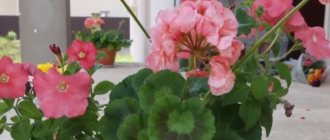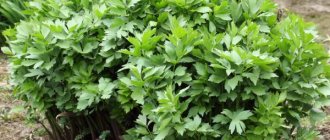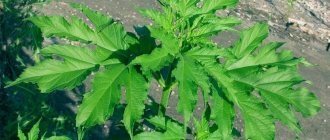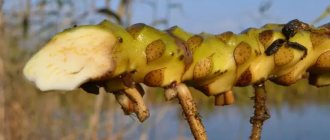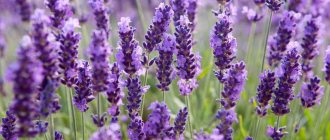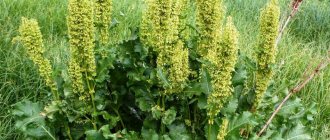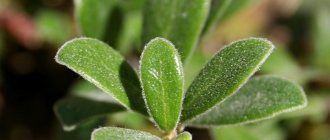Thistle is a genus of plants in the Asteraceae, or Asteraceae, family, common in Europe, Asia and North Africa.
Generic name Lat. Cárduus - thistle, comes from the ancient Latin name applied to thorny plants.
The Russian botanical name of the genus comes from the folk name of a group of weedy thorny plants belonging to different species of Cardus, Arctium, Cirsium, which are sometimes still called thistle in different areas.
The meaning is translated as “frightening devils,” which reflects its special medical and magical function - to ward off evil spirits.
Distinctive features, description
Thistle is a herbaceous perennial plant with spiny, hard, sessile or short-petioled leaves. Thistle spines cover flower heads and leaves.
The spines are sharp and long. And only the petals are fluffy and delicate, pointed in shape.
The stem of the plant is thick, erect and branched at the top. Thistles can reach up to two meters in height.
The flowers are bright purple, in spiny baskets. The baskets are mostly single, or there are several on the upper parts of the branches and stem.
Kinds
Milk Thistle Milk
thistle is a type of thistle that you can plant yourself.
Currently, there are about 130 species of this plant. But only some of them have medicinal properties and are used in folk medicine.
- Milk thistle - since this plant is classified as a weed, it can be planted where it is convenient for the gardener, as long as the place is sunny. It is planted mainly along the fence, creating a hedge from this medicinal plant.
- Curly thistle is a herbaceous plant that grows no more than a meter in height and has an erect stem. The leaves and flower baskets have sharp spines. It differs from the tartar in that the leg of the basket is very elongated, and it does not have spines. The whole of Western Siberia is considered its homeland.
- Drooping thistle - this plant grows up to one meter in height, the stem is weakly branched. Baskets with flowers do not have thorns. The leaves vary in length along the entire height of the stem. The lower ones reach 55 cm in length, and the upper ones are only 6 cm.
If you dreamed of thistle in a dream
Particular attention should be paid to dreams about a plant. Cutting thistle grass promises regret from a rash act
The road through a wasteland overgrown with plants promises difficulties that will be resolved unexpectedly.
You should not perform rituals using this herb without knowing the subtleties and features of magic. In this area it is better to trust the professionals. Because if you follow the nuances ineptly and inaccurately, you can invite disaster.
Thus, thistle protects against troubles and is an indicator of human weaknesses. Therefore, you should not destroy this plant if it has settled on the site. Perhaps it protects the house from evil. But it can also be considered a sign that the people around you are not what they really seem to be.
Magic properties
Since ancient times, it has been used both in medicine and in cooking and magical rituals. This is a very strong plant, which certainly has magical powers, capable of driving away evil spirits and evil in general. Thistle translated from Old Russian means “scaring devils.”
This is quite consistent with the abilities of this plant. Devils are really afraid of it, so this plant was hung at the entrance to the house to prevent evil spirits from entering the home.
They planted thistles on the graves of sorcerers and damned people to prevent evil spirits from dragging their souls into hell.
This plant was not used in smoking - the smoke of thistle is very bitter and eats the eyes and throat. It drives out the evil spirits, but it’s also difficult for people to stay in such a haze.
The thistle reaches its greatest strength when its flower blooms. Thistle is a reliable protection against damage caused by envy. They say that a dry thistle flower, on which the hair of the owner is wound, not only protects against many spells, but also “returns” them to the one who cast them.
The flower must be changed every summer, cutting it off on the hot afternoon preceding the new moon. In this case, you need to make sure that there are no strangers around.
Before the full moon, you should wear both flowers together, and then burn the old one on a live fire, after saying goodbye and thanking it. It is characteristic that each subsequent talisman absorbs the power of the previous one.
According to legend, thistle drives away devils and dead vampires. To do this, you need to carry the entire plant with you. The smoke of incense made from thistle is used to fumigate firearms that do not shoot well: that is, during a hunt they wound but do not kill game.
Potion to destroy evil spirits
Ingredients: Lavender, mimosa, thistle, spring water.
Tools: cauldron, clay cup, silver spoon, magic knife, cutting board (porcelain or wood).
Preparation:
First, you need to add crystal water to a clay cup, then put pieces of finely chopped lavender there, measured using a silver spoon, wait until something similar to tea comes out of it, you should start cutting the thistle rhizome on a porcelain board.
After adding the tincture, place the kettle on low heat and cook for 20 minutes, stirring clockwise every 7 minutes. The final potion should have a silvery tint.
Steam will rise above the potion after three days. After this, you need to pour the potion into special vessels and place them around the room, from where you need to drive out evil spirits.
At the same time, you need to say a spell:
Lavender, mimosa, Holy thistle (Holy shamrock), Banish Evil, dispel it in time, Let this moment disappear forever.
From the evil eye
Thistle grass also has a magical ritual effect.
The use against the evil eye is widely known among people:
- A prickly bouquet kept in the house is believed to be able to ward off sorcerers and evil spirits; copes with poltergeists.
- Charms soaked in its healing juice are powerful amulets that protect against damage. If you drop juice on a photo of your ex-loved one, you can get rid of attachment.
- A chapel placed at the head of the bed helps to ward off nightmares.
Magic herb thistle for amulets and amulets
- During the winter holidays. To do this, dried thistle is placed under the pillow for seven days. Then they ask the healers to boil this plant with wax and incense. The processed thistle is sewn into an amulet and worn as a talisman.
- At noon before the new moon. In order to take advantage of the magical properties of the plant, you need to cut the thistle flower at twelve o'clock in the afternoon, dry it, wrap it in your hair and carry it with you. Its effect will be valid even if the owner forgets the talisman at home.
- Storage as a herbarium. But every old flower must be burned. Old and new thistles are worn until the full moon, then the old flower is burned. Before burning, the old talisman must be thanked. It is believed that each new amulet is stronger than the previous one.
Before making a talisman, it is important to understand what this concept means and what are the main nuances when creating this magical remedy. The amulet is a special talisman, the main function of which is protection from harm
This item should not be confused with an amulet
The amulet is a special talisman, the main function of which is protection from harm. This item should not be confused with an amulet.
The main differences between a talisman and an amulet:
- Manufacturing process. Amulets are created by sorcerers and healers. The amulet is created by the person himself.
- Purpose of creation. When a person believes that he is wanted or has been harmed, he orders the making of an amulet. The amulet is used as a prevention against the forces of evil and unkind people.
- Affiliation. An amulet is an individual way of protection. It cannot be passed on to relatives or friends. The making of the amulet is aimed at the safety of the whole family.
Faith in the talisman. Many people know that thought is material. Only sincere faith will guarantee the protection of this thing. Mistrust and doubts will destroy and spoil the effect of using the amulet. Secrecy of the ritual. No one close to you should know or see the process of creating the ritual. Suspicions and fears will not only destroy the power of the talisman, but will also worsen relationships. Some relatives may try to take the creator of the amulet to a psychiatrist. Choosing the time to make the talisman
At this stage it is important to realize whether it will be lunar or solar. The solar talisman is created during the day under the influence of rays
The days of the summer and winter solstice are the strongest for making solar amulets. Moon amulets are made at night, provided the sky is clear. The night of the full moon is the most suitable option for creating the most powerful amulet. Winter Christmastide is also considered a good time to create a thistle talisman.
Home protection
The plant cannot be denied its visual appeal, although the idea of collecting a bouquet of flowering stems and putting it in a vase somehow never comes to mind. By the way - completely in vain! Thistle expels any evil from the house (from those very notorious “devils” to ordinary negative emotions left by ill-wishers). Such a bouquet will perfectly protect the family from discord and scandals if their cause lies in someone else’s slander.
Bloom
Thistle grass exhibits its magical properties to the maximum during the flowering period. It is at this time that it should be collected and dried for future use. Further such blanks are used as needed. A sick person can put a bag of crushed dried flowers under his pillow, and an unlucky person can make a personal amulet from one small twig tied with hair.
Application
- In order to prevent evil from entering the house from the outside, it is advisable to pour powdered rhizomes under the threshold.
- You can protect yourself from envious or selfish people with a dry bundle hanging near the front door.
- There used to be a belief: lightning would not strike a house if, at the first sign of a thunderstorm, you burned several flowers stored in the stove.
- Thistle potion was mixed with incense and worn on the chest to ward off robbers and prevent accidents.
Medicinal properties
Due to the large number of active components in the plant, thistle tincture and decoction are used in the fight against a fairly wide range of diseases.
Thistle-based remedies are used in the fight against a fairly wide range of diseases
Such pathologies include:
- gout (a chronic disease characterized by impaired protein metabolism and the inability of the liver to remove uric acid);
- hypotension;
- cold;
- cystitis (bladder disease);
- urethritis (inflammation of the urethra);
- hemorrhoids (poor blood circulation in the lower rectum);
- swelling;
- cough;
- bronchial asthma;
- nervousness;
- disruptions of the menstrual cycle;
- tuberculosis;
- diseases of the joints and heart;
- convulsions;
- potency disorders;
- memory problems;
- liver diseases (hepatitis);
- insomnia;
- anthrax;
- cancer of the skin and internal organs;
- ulcers and boils.
A decoction of thistle rhizome and the juice of this medicinal plant are effective means in the fight against cancer of the skin, internal organs and systems.
Treatment of bronchitis
To get rid of a disease such as bronchitis, you need to pour one tablespoon of dry material into 300 grams. boiling water
Boil for 10 minutes, cool and strain, discarding the leaves. Taken orally 50 g. three times a day after meals.
Treatment of cystitis and hemorrhoids
The decoction is made from leaves taken in the amount of one tablespoon, 200 grams are added. boiling water After this has infused, it is taken orally as often as possible.
If, when making a decoction, you take twice as many leaves, then this decoction can be used to wash festering, inflamed wounds.
Thistle syrup to relieve laryngitis and asthma
For this 150 gr. dry milk thistle mass is poured into 300 grams. water and add 150 gr. Sahara. All this is brought to a boil and boiled down to a syrup over low heat or a steam bath.
The broth should reduce by half its weight. Take a teaspoon 15 minutes before meals. Store syrup only in the refrigerator.
Also in the old days it was considered useful to take sprouted thistle seeds. Tea made from thistle leaves is taken for severe poisoning, including alcohol poisoning. If you grind the seeds in a coffee grinder, then taking them you can reduce weight and blood sugar.
To cleanse the blood
Take 30 gr. crushed thistle seeds and pour 500 g. boiling water Everything must be boiled using a steam bath until the total volume of the broth is reduced by half.
Take it at the end of every hour, one tablespoon for 12 hours. All this is done within 20 days, then a two-week break is taken and, if desired, the course of treatment can be repeated.
Milk thistle meal and oil
Milk thistle meal
Milk thistle is used in medicine to restore liver function; this medicinal herb is especially useful in the treatment of hepatitis and for relieving clinical signs of cirrhosis. Milk thistle is used in such cases in the form of decoction, oil and meal.
Meal is milk thistle seeds, which are finely ground into flour.
You can prepare the meal yourself by grinding milk thistle seeds in a coffee grinder. Many people use commercial meal, which can be purchased at a pharmacy.
Making butter yourself is quite problematic; it’s easier to buy it.
Milk thistle oil is used to treat skin diseases, it helps relieve symptoms of allergic rashes, promotes rapid healing of wounds, providing not only a regenerating effect, but also an antibacterial effect.
You can take thistle oil internally, but you need to do this very carefully, first diluting the oil with water. For a therapeutic effect, the course of use of milk thistle must be at least 30 days, 3 times a day. But you shouldn’t overuse medicinal herbs, as this can lead to unpleasant symptoms and an allergic rash.
Meal should be taken 30 minutes before the main meal up to 3 times a day. If you need to use milk thistle for a longer period of time, you should take a short break of several weeks and only then repeat the course again.
Indications for use of thistle
In complex therapy, the medicinal properties of thistle have a beneficial effect in the following pathologies:
- Liver diseases (hepatitis, cirrhosis);
- diseases of the gallbladder and biliary tract (cholecystitis, atony of the gallbladder, cholelithiasis);
- diseases of the gastrointestinal tract (gastritis, gastroenteritis, constipation, hemorrhoids);
- spleen diseases;
- nervous system disorders (neuroses, insomnia, depressive states);
- diseases of the urinary system (cystitis, edema);
- skin lesions (burns, rashes, inflamed and non-healing wounds);
- diseases of the respiratory system (bronchitis, tuberculosis);
- gynecological problems (menstrual irregularities).
Application in cosmetology
Thistle is also widely popular among cosmetologists.
Thanks to the large amount of minerals and vitamins, its oil can be successfully used in the following cases:
- rejuvenation and regeneration of skin tissue;
- giving elasticity and firmness to the skin;
- treatment of acne, dermatitis, eczema, psoriasis, burns and inflammation;
- smoothing wrinkles;
- improvement of skin microcirculation.
If there is a rash, redness, or black spots on the skin, make masks with plant oil. To do this, a few drops of it are mixed with a small amount of daily cream and applied to problem areas.
Wash off after 15 minutes.
Problem skin can be wiped using a decoction of the flowers or leaves of the plant.
Milk thistle is the most commonly used type of thistle by cosmetologists.
Contraindications
Thistle is a low-toxic medicinal plant. Numerous studies have not revealed any significant side effects on the body after its use.
However, allergic reactions, overexcitability are possible when using small doses of the drug, and depression of the central nervous system is possible when taking large doses.
There have been no recorded cases of adverse reactions from thistle.
The use of weed must be taken with full responsibility, taking into account all indications and contraindications. Before starting treatment, you must consult a doctor.
Contraindications to the use of thistle and preparations based on it:
- appendicitis;
- pancreatitis;
- hepatic colic;
- individual intolerance to plant components;
- children up to 3 years old.
Thistles on the graves of sinners
To cleanse the home from the negative influence of otherworldly forces, the Slavs, before moving into it, fumigated the room with thistle. This method was also used during religious holidays.
In addition, the plant was planted on the graves of people who sinned greatly during their lifetime. Believers believed that by doing so they were creating a barbed barrier against black magicians and witches, who did not leave them even after death. It was believed that they could drag the souls of the dead to hell even before the Last Judgment.
Cyberpunk 2077 developer: big game update won't be released until June
Appetizing braided meat with cream and ham and cheese: scissors will help you
“I didn’t really understand”: Samburskaya about where her first salary for “Univer” went
Collection and preparation
The leaf mass begins to be collected from this plant from the beginning of summer. The roots are dug up in spring and autumn. After digging, they are divided into two halves, cutting it along the rhizome, and hung in the air in the shade so that it does not lose its healing qualities.
The vegetative part is cut off with sickles or knives during the flowering of milk thistle. It is imperative that the one who will collect thistles wear clothes with long sleeves and trousers, and his palms must be protected with gloves.
Since there are quite sharp spines throughout the stem. The greens are also dried in the shade under a canopy so that the occasional summer rain does not wet them.
In order for the flower baskets to dry well, they are laid out on a sieve with white paper underneath it. After they dry, carefully open the baskets and remove the seeds. After this, proceed directly to drying the seeds.
The seeds are laid out in a thin layer and allowed to dry for 2 days. After that, put them in a breathable bag and put them in a dry, dark place.
Plant cultivation
The genus of eryngiums has about 250 species. In nature, as well as during artificial cultivation, eryngium, especially the flat one, grows better in open and bright places with enough sun
It is important that the soil is well drained - the root system of the flower does not tolerate stagnant moisture. But in general, its cultivation does not require special knowledge in ornamental gardening.
The plant is unpretentious and resistant to both bad weather conditions and insufficient care.
When planting and replanting, for each intended place where the plant will be located, it is advisable to add 1-2 handfuls of lime in the form of ground egg shells. This is necessary so that the inflorescences of an adult plant have a more beautiful and brighter color. It is worth noting that the good thing about flat-leaved eryngium is that it is completely unpretentious and can feel great even on soils that are quite arid and poor in nutrients. At the same time, his flowers only become brighter. Tolerates winter cold well.
The plant reproduces both by seeds and division. At the same time, only experienced gardeners can propagate eryngium by division, since the plant is fragile, and its roots often break when dividing. It also often happens that separated parts of rhizomes do not take root at all. It should be remembered that the separated parts of the roots should be planted in the ground, maintaining a distance of 30-40 cm between them.
Planting and care
Still, milk thistle is a classic weed, but it also looks good as a tapeworm in the flowerbed. The main thing is not to let it fill the entire space of the garden.
In order to grow thistles, you need to choose a dry place open to the sun. Places where people walk should be avoided, as if it grows strongly it will sting passers-by. Therefore, it is often planted in the center of the flowerbed or in the far corner.
Seeds are planted immediately into the ground to a depth of 2 cm, either in late autumn or in April. The soil does not matter, but the more fertile the soil, the taller and more luxuriant the milk thistle bush grows. It begins to bloom in July, and flowering lasts for a long time until frost hits.
It is imperative to pick fading thistle flowers, as the seeds will be scattered by the wind around the plant over a large area.
Thistle reproduces remarkably well with the help of its seeds, and new varieties can be planted yourself in the month of April. A couple of months after the seeds germinate, the flower blooms. It will be possible to collect flowers for medicinal purposes after four months.
When purchasing seeds in specialized seed stores, you need to pay attention to the expiration date of the packaging, since expired seeds produce a small number of shoots.
Seeds are planted in beds prepared in the fall, making small depressions no more than 2 cm; most fresh seeds germinate within 10 days.
Sprouted seeds look very attractive in the garden, and caring for them is a real pleasure. You can make a seedling bed in a wide pot and place it for decoration, somewhere at the entrance to the house, and later, when the seedlings grow, plant it in the right places on the site.
Milk thistle tolerates replanting excellently, but when planting it in a permanent place, one must take into account the fact that as it grows it will take up a lot of space.
The soil
The richer the soil, the more attractive thistles look. Therefore, if the soil on the site is scanty, but you want to get an excellent flowerbed decoration, you need to add humus and ash when planting in the planting hole.
Watering and fertilizing
Although it is a weed, it requires watering in dry weather. Then his external data will look much more attractive and will please the eyes of the people around him longer. Wood ash can be used for feeding.
Thistle and love magic
Our ancestors believed that the plant has enormous magical properties. Thistle was used as a ritual plant; amulets and herbal dolls were made from it - it was believed that they had enormous protective power. The simplest amulet is a plant branch tied with hair. To do this, the plant had to be cut at noon during the waxing moon. Such an amulet protects against negative influences, damage, and returns evil to the offender.
Previously, a mantle was always planted on the grave of the deceased; people believed that its roots would protect the deceased, or rather, his soul, and would not allow devils to enter the coffin and drag the soul of the deceased to hell for the sins that he had committed during his lifetime.
When changing place of residence or on church holidays, it was necessary to carry out a ritual to cleanse the house of evil spirits, negativity, and anger. To do this, the grass was collected and dried, then it was set on fire and the smoking grass was passed around all the rooms. After that, it was left outside the house so that it could smolder until the end.
It is also believed that the flower helps to see prophetic dreams. To do this, you need to prepare a decoction by mixing equal quantities of lavender and thistle flowers with mimosa and fern rhizomes. The mixture is boiled for 20 minutes; you can stir it only with a silver spoon. If you take such a decoction before bed for three days, then on the last night you will definitely have a prophetic dream that will tell you in detail about the future.
By planting this handsome thorny plant on your garden plot, you can get not only a decorative garden decoration, but also a useful medicinal plant, which also protects the house and its residents from negative influences.
Attention, TODAY only!
The biennial herbaceous plant came to us from Europe, although the main place of growth is Asia. There are legends about the magical qualities of the plant from the Asteraceae family. They are interesting, but very controversial. But the medicinal beneficial properties are known in folk medicine and do not raise any doubts. People call it “Tatarnik” and “Bodyak”. There are contraindications, so consultation with a doctor is recommended before use.
Directly in love magic (i.e., for the purpose of awakening feelings), the plant was used extremely rarely. The only exception is a love spell on thistle, performed on a married man. In this case, the grass was not taken for the sake of creation; with its help, they tried to destroy the attachment that the object of divination felt for his legal wife.
Thistle is a vibrant member of the Asteraceae with pink-purple blooms. Its distinctive feature is the inflorescences, surrounded along the edge by leaves with spiny tips. Thistle has been attributed magical properties at different times.
For example, today in rural areas many people are wary of people growing this plant on their property. It, according to legend, settles in those places where evil spirits are located.
Thistle, the beneficial properties and contraindications of which are described in this article, is designed to fight devils, which is where its name actually comes from. It was hung over the entrance doors so that evil spirits could not get into the house. The flower of this plant was often plucked and carried with them, trying to protect themselves from damage and the evil eye.
Thistle (its beneficial properties and contraindications are described below) grows on roadsides and meadows. Currently, there are about 100 species, among which the most common are termera, curly, prickly, small-headed and drooping. In traditional medicine, the leaves, stems, roots and flowers of this plant are used. Its greens are collected throughout the summer, and the rhizomes are dug up in the fall and spring to get the maximum benefit from the plant.
In this article we will learn what thistle is. The properties, uses and contraindications, as well as the magical properties of this plant, will also be discussed below.
First of all, the plant was used specifically for healing magical ailments - damage or the same. It was believed that it “erases” traces of someone else’s negative influence, clears consciousness, and returns to the victim strength and the ability to independently control his own destiny. The thistle lapel could be especially successful, since the purpose of this rite is precisely liberation from “external control.”
People have long known about the magical properties of some plants. One of these plants is the thistle, the flowers of which are believed to have a special power to keep evil spirits out of your home. For magical protection, the grass was placed under the threshold, attached around the front door and on shutters. According to our ancestors, it could protect against various slander, protect against damage and people who could be jinxed. It is not for nothing that people gave it the name thistle - “scaring devils”, “thistle”.
Thistle belongs to the Asteraceae family and is a herbaceous perennial with a thick stem, strong rhizome and spiny leaves. Grows as a weed in meadows and roadsides in Europe, Asia, and North Africa. Some species reach two meters or more.
Flowering begins in mid-summer and ends at the end of September. Thistle flower is small, it looks very impressive in dry bouquets. The colors are very bright - mainly crimson, purple and pink shades, sometimes blue. The unusual beautiful color of this plant even gave the name to one of the shades in the color scale; it is called thistle color.
In total, about 120 species of this herb are found in nature. Some of them are so decorative that they are used in landscape design:
- lactic;
- curly;
- drooping.
Because of the way thistles look, they can be planted as a solitary plant in flower beds. The only drawback is that it grows quickly and is difficult to eradicate, so you need to constantly monitor the plant's growth.
Interesting Facts
In ancient times, thistle was used not only for healing and cooking, but was also used in various rituals.
People believed that this medicinal plant could drive out evil spirits both from humans and from homes. Based on this, they hung a small bouquet of these flowers above the door at the entrance so that evil spirits would not enter the house.
If it was believed that if a sorcerer died in a village, then thistles were necessarily planted on his grave so that he would not rise from the grave.
In ancient times, an amulet was created from thistle flowers. It was believed that if a person's hair was wrapped around a flower, it would protect him from evil spells directed against him.
The role of thistle in protecting the home
In Germany, this plant was attached to roofs to protect houses from witches. The Slavs believed that the god of lightning and thunder, Perun, patronizes thistles. But in the house the role of the thistle was limited to performing the following duties:
- Protection of livestock from diseases. For this purpose, thistle branches were hung over the door to the stable. In order to protect your home from troubles, you need to dry a cut branch of a plant with a flower and attach it above the front door and other possible exits. The presence of thistle guarantees the preservation of positive energy in the house.
- A remedy for damage, evil eye, curse. You can get rid of such things if you carry out a cleansing procedure using thistle. To do this, place the dry flower of the plant in a heat-resistant bowl and set it on fire. Then fumigate the whole house with smoke. An unpleasant smell and acrid smoke are the only drawbacks to the ritual, but otherwise you won’t get the result.
- Protection from fright. The energy of a child is the weakest, so children are most often attacked. You can relieve a child from causeless fear by placing a thistle flower under the pillow. To prevent the child from getting hurt, it is advisable to wrap the thistle with cloth.

